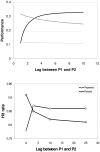What makes distributed practice effective?
- PMID: 20580350
- PMCID: PMC2930147
- DOI: 10.1016/j.cogpsych.2010.05.004
What makes distributed practice effective?
Abstract
The advantages provided to memory by the distribution of multiple practice or study opportunities are among the most powerful effects in memory research. In this paper, we critically review the class of theories that presume contextual or encoding variability as the sole basis for the advantages of distributed practice, and recommend an alternative approach based on the idea that some study events remind learners of other study events. Encoding variability theory encounters serious challenges in two important phenomena that we review here: superadditivity and nonmonotonicity. The bottleneck in such theories lies in the assumption that mnemonic benefits arise from the increasing independence, rather than interdependence, of study opportunities. The reminding model accounts for many basic results in the literature on distributed practice, readily handles data that are problematic for encoding variability theories, including superadditivity and nonmonotonicity, and provides a unified theoretical framework for understanding the effects of repetition and the effects of associative relationships on memory.
Copyright 2010 Elsevier Inc. All rights reserved.
Figures






Similar articles
-
Theoretical correlations and measured correlations: relating recognition and recall in four distributed memory models.J Exp Psychol Learn Mem Cogn. 2005 Sep;31(5):933-53. doi: 10.1037/0278-7393.31.5.933. J Exp Psychol Learn Mem Cogn. 2005. PMID: 16248743
-
The propositional approach to associative learning as an alternative for association formation models.Learn Behav. 2009 Feb;37(1):1-20. doi: 10.3758/LB.37.1.1. Learn Behav. 2009. PMID: 19122048
-
Elemental representation and configural mappings: combining elemental and configural theories of associative learning.Learn Behav. 2012 Sep;40(3):320-33. doi: 10.3758/s13420-012-0079-1. Learn Behav. 2012. PMID: 22927004
-
Theories of the generation effect and the impact of generation constraint: A meta-analytic review.Psychon Bull Rev. 2020 Dec;27(6):1139-1165. doi: 10.3758/s13423-020-01762-3. Psychon Bull Rev. 2020. PMID: 32671573 Review.
-
[On-line processing mechanisms in text comprehension: a theoretical review on constructing situation models].Shinrigaku Kenkyu. 2004 Dec;75(5):442-58. doi: 10.4992/jjpsy.75.442. Shinrigaku Kenkyu. 2004. PMID: 15747568 Review. Japanese.
Cited by
-
On the importance of looking back: the role of recursive remindings in recency judgments and cued recall.Mem Cognit. 2013 Jul;41(5):625-37. doi: 10.3758/s13421-013-0298-5. Mem Cognit. 2013. PMID: 23371792 Clinical Trial.
-
Preservation of long-term memory in older adults using a spaced learning paradigm.Eur J Ageing. 2023 Feb 1;20(1):2. doi: 10.1007/s10433-023-00750-5. Eur J Ageing. 2023. PMID: 36723694 Free PMC article.
-
Repetition learning is neither a continuous nor an implicit process.Proc Natl Acad Sci U S A. 2023 Apr 18;120(16):e2218042120. doi: 10.1073/pnas.2218042120. Epub 2023 Apr 11. Proc Natl Acad Sci U S A. 2023. PMID: 37040406 Free PMC article.
-
Familiar Strategies Feel Fluent: The Role of Study Strategy Familiarity in the Misinterpreted-Effort Model of Self-Regulated Learning.J Intell. 2022 Oct 12;10(4):83. doi: 10.3390/jintelligence10040083. J Intell. 2022. PMID: 36278605 Free PMC article.
-
The roles of working memory and intervening task difficulty in determining the benefits of repetition.Psychon Bull Rev. 2013 Apr;20(2):341-7. doi: 10.3758/s13423-012-0352-5. Psychon Bull Rev. 2013. PMID: 23224905 Free PMC article.
References
-
- Anderson JR, Schooler LJ. Reflections of the environment in memory. Psychological Science. 1991;2:396–408.
-
- Appleton-Knapp SL, Bjork RA, Wickens TD. Examining the spacing effect in advertising: Encoding variability, retrieval processes, and their interaction. Journal of Consumer Research. 2005;32:266–276.
-
- Bäuml K. The list-strength effect: Strength-dependent competition or suppression? Psychonomic Bulletin & Review. 1997;4:260–264. - PubMed
-
- Begg I, Green C. Repetition and trace interaction: Superadditivity. Memory & Cognition. 1988;16:232–242. - PubMed
-
- Belleza FS, Winkler HB, Andrasik F., Jr Encoding processes and the spacing effect. Memory & Cognition. 1975;3:451–457. - PubMed
Publication types
MeSH terms
Grants and funding
LinkOut - more resources
Full Text Sources
Medical

